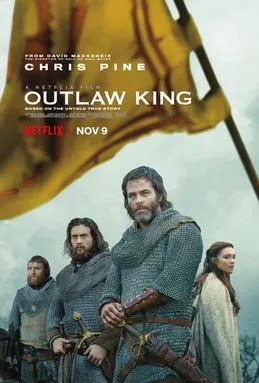Historical accuracy of Outlaw King

Historical accuracy of Outlaw King

Characters
Robert the Bruce
The film captures his coronation, key battles (Methven, Loudoun Hill), and guerilla tactics accurately. However, it simplifies his earlier shifting allegiances and compresses the timeline significantly.
Elizabeth de Burgh
She was Robert's real second wife and was captured by the English. The film alters the timing of their marriage and may conflate her imprisonment conditions with those of other Bruce women.
Edward I of England
Portrayed as a formidable and determined adversary to Scottish independence, consistent with historical accounts of his campaigns and actions (like using the Warwolf trebuchet).
Edward, Prince of Wales
While Edward II was considered less capable than his father, the film exaggerates his incompetence/cruelty and invents his presence and a one-on-one duel with Bruce at Loudoun Hill, which is entirely fictional.
James Douglas, Lord of Douglas
Accurately depicts his unwavering loyalty to Bruce and his famed ferocity ("Black Douglas," the "Douglas Larder"). His almost unhinged intensity might be heightened for dramatic effect.
Angus MacDonald
Based on Angus Og MacDonald of Islay, who historically gave Robert the Bruce crucial support and shelter during his time as an outlaw.
More characters
John Comyn
Accurately depicts the pivotal historical event of Bruce killing his rival claimant, John Comyn, Lord of Badenoch, within Greyfriars Kirk, Dumfries.
Aymer de Valence
Accurately portrayed as a key English commander who defeated Bruce at the Battle of Methven but was later defeated by Bruce at the Battle of Loudoun Hill.
Robert Wishart
Wishart was a real Bishop of Glasgow and a key patriotic churchman who supported Bruce's claim to the throne, absolved him of Comyn's murder, and aided his cause.
Neil de Bruce
Neil was Robert's real brother who supported his kingship. He was captured defending Kildrummy Castle (holding Elizabeth and Marjorie) and brutally executed by the English, as shown.
Thomas de Bruce
Thomas was Robert's real brother who supported his claim. He was captured at Loch Ryan and executed by the English.
Alexander de Bruce
Alexander was Robert's real brother who supported his claim. He was captured alongside Thomas at Loch Ryan and executed by the English.
Marjorie Bruce
Marjorie was Robert's daughter from his first marriage. She was captured by the English along with Elizabeth de Burgh and suffered harsh imprisonment (caged, though the film may downplay this).
Isabella MacDuff
Isabella MacDuff famously defied her husband (a Comyn ally) and asserted her family's right to crown the King of Scots at Scone. She was later captured and caged by Edward I for her actions.
Sir James Macfarlane
Appears to be a fictional composite character representing the loyal soldiers who joined Robert the Bruce's cause.
Lord Mackinnon
Represents Clan Mackinnon. While the specific character/interaction might be fictionalized, the clan did exist on Skye and eventually supported Robert the Bruce.
Story
The Battle of Loudoun Hill
The Battle of Loudoun Hill did occur and was a Scottish victory. The film portrays this battle, but some details of the tactics and the specific course of events are likely dramatized.
The killing of Red Comyn
Robert the Bruce did kill John Comyn (Red Comyn). The circumstances surrounding the killing, including whether it was premeditated or in self-defense, are debated by historians. The film presents a specific version of the event, but it is not definitively known.
The relationship with Elizabeth de Burgh
Robert the Bruce's marriage to Elizabeth de Burgh was a historical fact. The film portrays their relationship, but the intimacy and some details of their interactions are fictionalized.
The timeline of events
The film condenses and alters the timeline of some events for narrative purposes. While the general sequence of events is maintained, some specific dates and durations are changed.
Setting
The state of Scotland
The film accurately reflects the turbulent and fragmented state of Scotland during the Wars of Scottish Independence, with various factions vying for power and loyalty.
The use of medieval weaponry
The film depicts the use of medieval weaponry and armor. While generally accurate, some specific details of the arms and armor used might be simplified or not entirely period-accurate.
Medieval Scottish culture
The film attempts to portray aspects of medieval Scottish culture. While some elements are likely accurate, others might be romanticized or based on broader medieval stereotypes rather than specifically Scottish practices.
The brutality of the era
The film does not shy away from depicting the brutality and violence of the medieval era, which is historically accurate. Warfare and punishments were often harsh and unforgiving.
The role of the Church
The film shows the influence of the Church in medieval society and its involvement in political affairs. This is a historically accurate portrayal, though the specific interactions and pronouncements of church figures are dramatized.
The landscape of Scotland
The film makes good use of the Scottish landscape, which is a crucial element of the story. The scenery and settings contribute to the film's atmosphere and historical authenticity.
